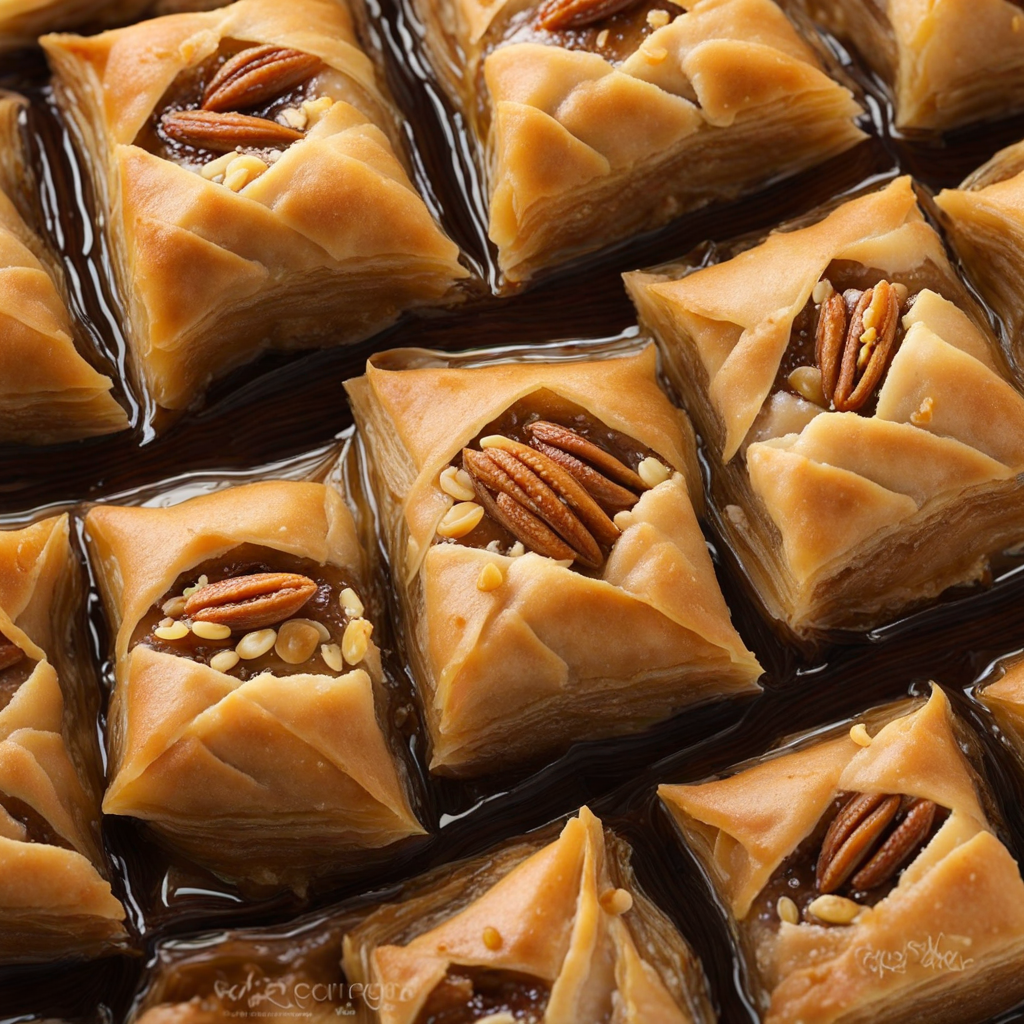Loukoumades
Loukoumades are delightful, bite-sized Greek pastries that have found a special place in Cypriot cuisine. These golden, fluffy dough balls are deep-fried to perfection, achieving a crispy exterior while retaining a soft, airy center. The dough is made from simple ingredients like flour, yeast, water, and a touch of sugar, resulting in a tender treat that can be enjoyed at any time of the day. Traditionally served warm, they are often garnished with a dusting of powdered sugar or cinnamon, enhancing their irresistible appeal. Once fried, Loukoumades are generously drizzled with a sweet syrup made from honey, sugar, and water, which seeps into the dough, infusing each bite with a rich sweetness. This syrup not only adds depth but also a glossy finish that makes them visually enticing. In many variations, they may be topped with crushed nuts, such as walnuts or pistachios, lending a delightful crunch that perfectly contrasts the soft dough. The combination of textures and flavors creates a delightful experience that transports you to the sun-drenched shores of Cyprus with every bite. Loukoumades are often enjoyed as a dessert or a sweet snack, making them a popular choice at festivals and gatherings. The joy of sharing these treats with friends and family enhances their enjoyment, as the warm, syrup-drenched dough balls are meant to be savored together. Whether indulging in the classic version or experimenting with flavors like chocolate or fruit, Loukoumades offer a sweet escape that's both comforting and delicious, making them a must-try for anyone wanting to explore the culinary treasures of Cyprus.
How It Became This Dish
The Sweet History of Λουκουμάδες: Cyprus's Beloved Delicacy #### Origins: A Taste of Antiquity The story of Λουκουμάδες (loukoumades) is steeped in the rich tapestry of Cypriot culture, drawing from ancient traditions that stretch back millennia. The roots of this sweet treat can be traced to the Byzantine Empire, where similar fried dough delicacies were enjoyed by emperors and common folk alike. These early versions of loukoumades were often drizzled with honey and sprinkled with sesame seeds, embodying the simple yet profound relationship between the Cypriots and their natural resources. The term "loukoumades" itself is derived from the Arabic word "luqma," meaning "a morsel," reflecting the dish’s bite-sized nature. As Cyprus has been a crossroads of civilizations, this dish absorbed influences from various cultures, including the Ottoman Turks, who popularized its consumption in the Eastern Mediterranean during their rule. The Turkish version, known as "lokma," is quite similar, showcasing the shared culinary heritage in the region. #### Cultural Significance: A Symbol of Celebration In Cyprus, loukoumades are more than just a dessert; they are a symbol of celebration and community. Traditionally served at weddings, christenings, and local festivals, these golden-brown morsels are often prepared in large batches to feed gatherings of family and friends. The act of making loukoumades is often communal, with families coming together to mix, fry, and serve the dough, fostering bonds between generations. During the festive period of Lent, loukoumades take on a particularly significant role. As a dish that can be enjoyed without dairy, they provide a delicious alternative for those observing the fast. The preparation of loukoumades during this time often involves a ritualistic element, where families gather to break bread and share stories, reinforcing the idea that food is a cornerstone of cultural identity and familial ties. #### Development Through the Ages As Cyprus transitioned through various historical epochs—from Byzantine glory to Venetian influence and Ottoman rule—the preparation and popularity of loukoumades evolved. In the 19th century, as sugar became more accessible, the sweetness of loukoumades was heightened with generous amounts of honey and sugar syrup. Local variations began to emerge, with some regions opting for flavored syrups infused with rosewater or citrus, adding a distinctive twist to this classic treat. The 20th century saw a resurgence of interest in traditional Cypriot cuisine, with loukoumades at the forefront. Street vendors began to sell these delightful bites at markets and festivals, ensuring that the treat remained a beloved staple of everyday life. The accessibility of ingredients and the simplicity of preparation meant that even the most modest households could partake in this sweet indulgence. In contemporary Cyprus, loukoumades continue to be a cherished delicacy, often found in both casual settings and upscale restaurants. They have also become a focal point in pastry shops, where innovative chefs experiment with flavors and presentations. Some variations now include chocolate or caramel fillings, while others are served with ice cream or fresh fruit, showcasing the adaptability of this traditional dish. #### The Modern Revival and Global Reach The global diaspora of Cypriots has also played a significant role in the transformation of loukoumades. As Cypriots settled in various parts of the world, they carried their culinary traditions with them. In cities like London, Sydney, and New York, loukoumades have found new audiences, often served at cultural festivals or in Cypriot restaurants that aim to preserve and share their heritage. Social media has also contributed to the popularity of loukoumades, with food bloggers and influencers showcasing their unique takes on the dish. Instagram-worthy presentations, such as stacking the dough balls high and drizzling them with colorful syrups or toppings, have made loukoumades not only a treat for the palate but also a feast for the eyes. This modern twist has attracted younger generations and food enthusiasts, ensuring that the legacy of loukoumades remains vibrant. #### The Art of Making Loukoumades At its core, the preparation of loukoumades is a straightforward process that requires only a few basic ingredients: flour, yeast, water, and a pinch of salt. The dough is allowed to rise before being dropped by spoonfuls into hot oil, where they puff up and turn golden brown. Once fried, they are typically drenched in syrup made from honey and water, sometimes flavored with cinnamon or lemon zest. The beauty of loukoumades lies in their versatility. While the classic version is delightful on its own, many choose to enhance their flavor with toppings such as crushed walnuts, cinnamon, or even a drizzle of chocolate. The dish can be served warm, fresh from the fryer, or enjoyed at room temperature, making it a perfect snack for any occasion. #### Conclusion: A Sweet Legacy In conclusion, loukoumades represent a rich and evolving tradition in Cypriot cuisine, encapsulating centuries of history and cultural exchange. From their ancient origins to their modern incarnations, these sweet morsels have transcended time and geography, embodying the spirit of community, celebration, and culinary creativity. As they continue to be enjoyed by Cypriots and food lovers around the world, loukoumades serve as a reminder of the power of food to connect people, preserve heritage, and create lasting memories. Each bite is not just a taste of sweetness but a journey through history, culture, and the enduring joy of sharing a meal.
You may like
Discover local flavors from Cyprus







